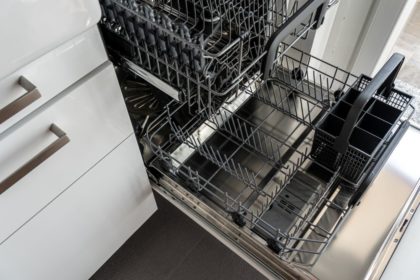
A clean dishwasher means cleaner dishes. It may seem silly to clean a dishwasher, but this simple task will help keep your machine working at it’s best. Cleaning your dishwasher every four to six weeks will help reduce buildup of lime scale, soap scum, and eliminate leftover food particles that reduce your machine’s effectiveness. Need some guidance on how to check this item off your list? We’ll share our tips and tricks on how to clean your dishwasher in 8 simple steps.
1. Check your Heat.
To best clean and sanitize your dishes and the inside of your dishwasher, your water heater temperature should be set to 120 degrees Fahrenheit. If you can hold your finger under running hot water for more than 2 seconds, we recommend you turn up the temperature of your water heater for this task. I
2. Empty the Filter.
Newer dishwasher models use a detachable cylindrical filter that’s located on the bottom of your machine. When food is washed away from your dishes, the large particles are captured inside the filter to avoid clogging the drain. So what happens to the food once it’s captured in the filter? It sits there until we clean it out. Kind of gross, right? That’s why we’re walking you through how to do this!
Older dishwasher models use what’s called a macerator, which grinds food up like a garbage disposal. This is the reason old machines are much louder than new models! The more you know.
If your dishwasher has a funky odor or your dishes are suddenly not coming out as clean, you should probably start with checking and cleaning the filter.
3. Clean the Filter.
Now, for the information you’ve been waiting for. For most dishwashers, removing the filter requires turning it counterclockwise and gently pulling it out. But all models are different, so your best bet is to find your dishwashers owner’s manual and follow the instructions.
Is your dishwasher manual missing? Many manuals can be found online by simply searching for the brand and model of your dishwasher.
Once you know where to look and what to do, emptying and cleaning your dishwashers filter and screen is an easy task that takes only a few minutes to complete. Remove the filter and screen and rinse under the faucet. I keep a small, soft bristled brush under my sink to gently scrub any hard to remove residue/gunk from the filter, as needed. Be sure to reinstall both the filter and screen back correctly. If they aren’t locked in place, food will be able to get through to your drain and we don’t want that!
If you pre-rinse your dishes, you should plan on checking and cleaning these filters once every three months. If you tend to leave food on dishes, you should check and clean them at least once a month. Remember the cleaner you keep your machine the longer it will last.
4. Inspect the Interior.
Since you will be removing the bottom rack to access the filter, now is a great time to survey the condition of your dishwashers interior. Check the floor of your machine for buildup paying close attention to the area nearest the drain.
Use your dishwasher detergent with a clean, damp cloth or sponge to wipe down the inside of your dishwasher.
5. Prevent and Remove Hard Water Deposits.
If you notice any white streaks inside your machine, they are hard water deposits, also known as limescale and calcium carbonate. Over time this buildup can clog the holes in your dishwasher’s spray arms and filter components so it’s important to clean this buildup away as often as possible. There are products on the market you can use for this, but many common household products will do the trick! Read section seven of this post for dishwasher cleaning hacks.
6. Watch What Goes in your Dishwasher.
Check for toothpicks, bones, fruit pits, etc. as you load your dishes into the washer. Be very careful to not put any dishes in the dishwasher with paper labels or pricing stickers. These items will quickly clog your machine and are very difficult to properly clean.
Also be wary of broken or chipped glass when you unload the dishwasher. Be sure to remove any broken pieces of glass from your dishwasher. Broken glass left in your washer will start breaking down and get inside your system – which is not good.
7. Home Remedies to Remove Odors & Stains.
Once you’ve cleaned your filter, place a dishwasher-safe container with one cup of white vinegar on the top rack of your empty dishwasher. Run a hot-water cycle. This will wash away built-up grease, gunk, and odors. Once that load is done, sprinkle a cup of baking soda on the bottom of the inside of your machine and run a short cycle. this will help keep your appliance smelling fresh. If you prefer, you can also purchase and use citric acid crystals for stains, hard water deposits, and soap build up.
There you have it, friends! We hope these steps help you next time you clean your dishwasher. Feel free to save or pin this post so you can reference it as needed.